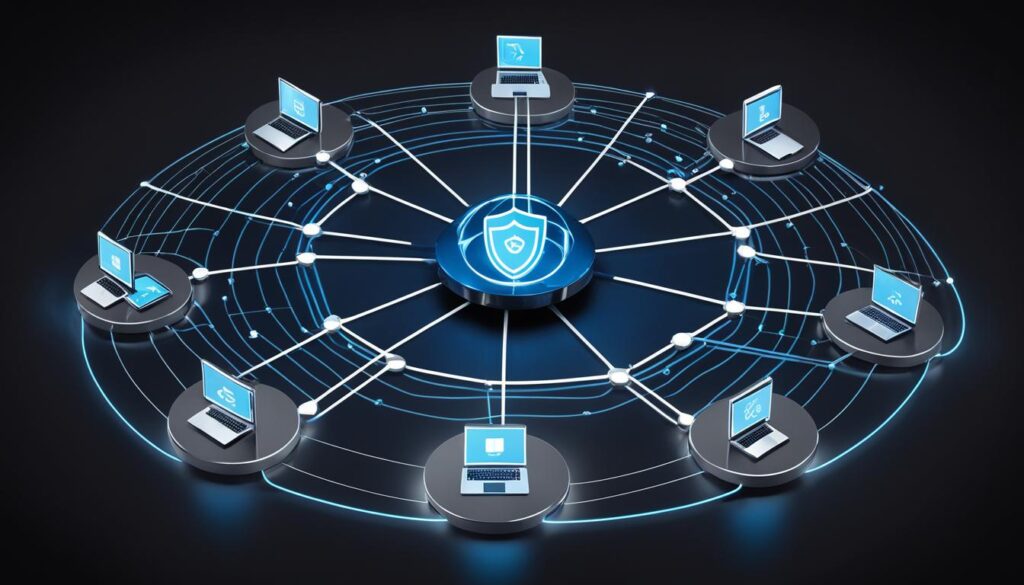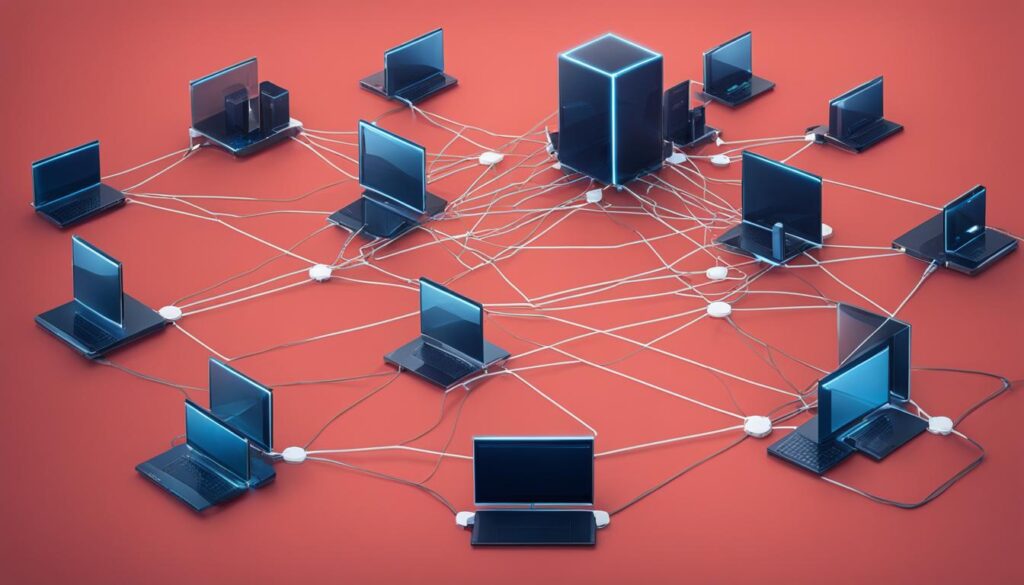Protecting your organization’s endpoints is paramount in today’s cybersecurity landscape. With the increasing reliance on remote work and the rise of sophisticated cyber threats, implementing a robust endpoint protection service is crucial to safeguard your network security and prevent data breaches.
A comprehensive endpoint protection service ensures that your network is defended against malware, advanced threats, and vulnerabilities. It combines powerful features such as malware detection, data breach prevention, advanced threat protection, and vulnerability management to keep your endpoints secure. In addition, endpoint protection service offers ransomware protection, real-time monitoring, and antivirus software to keep your organization’s data and infrastructure safe.
One notable endpoint protection service provider is Check Point, offering their Harmony Endpoint solution. Harmony Endpoint is a cutting-edge platform that combines endpoint protection platform (EPP) and endpoint detection and response (EDR) capabilities. It is available both as an on-premises solution and a cloud-based endpoint security service (ESaaS).
Key Takeaways
- Endpoint protection service is crucial for safeguarding network security and preventing data breaches.
- Key features of endpoint protection service include malware detection, data breach prevention, advanced threat protection, and vulnerability management.
- Ransomware protection, real-time monitoring, and antivirus software are essential components of an effective endpoint protection service.
- Check Point’s Harmony Endpoint combines endpoint protection platform (EPP) and endpoint detection and response (EDR) capabilities.
- Endpoint protection service can be deployed as an on-premises solution or a cloud-based endpoint security service (ESaaS).
Importance of Endpoint Security in the Modern Threat Landscape
Endpoint security plays a critical role in today’s ever-changing threat landscape. With the valuable data at stake and the increasing number of endpoints, traditional perimeter security measures alone are no longer sufficient to protect organizations from cybersecurity threats. Hackers are constantly finding new ways to exploit vulnerabilities and gain access to sensitive information.
Today, with the rise of remote work and the widespread use of personal devices, such as smartphones and laptops, endpoint security has become more important than ever before. The adoption of bring-your-own-device (BYOD) policies and the integration of Internet of Things (IoT) devices further increase the complexity of securing endpoints across the network.
Endpoint protection involves safeguarding the data and workflows associated with individual devices connected to a network. It includes next-generation antivirus solutions, endpoint detection and response (EDR), response automation, and extended detection and response (XDR) capabilities.
By implementing comprehensive endpoint security measures, organizations can protect themselves against a wide range of cyber attacks, such as malware infections, unauthorized access, data breaches, and ransomware attacks. It ensures the security and integrity of modern enterprises and mitigates risks associated with remote work and the ever-evolving threat landscape.
The Threat Landscape is Evolving
The rapid advancement of technology has brought about new cybersecurity threats that can target endpoints and network systems. Hackers are continuously finding vulnerabilities and exploiting them to gain unauthorized access to sensitive information, disrupt business operations, and cause financial and reputational damage.
Remote work has become more prevalent, with employees accessing company networks and data from home or while traveling. This poses additional security challenges, as personal devices may not have the same level of security as corporate-owned devices.
Furthermore, the adoption of BYOD policies and the proliferation of IoT devices in the workplace create additional entry points for cyber attacks. These devices often lack proper security measures, making them vulnerable to exploitation.
The Role of Endpoint Security
Endpoint security is essential for protecting endpoints against cyber attacks and ensuring the security of modern enterprises. It encompasses multiple layers of defense and includes features such as:
- Next-generation antivirus: Advanced antivirus solutions that go beyond signature-based detection to identify and block both known and unknown threats.
- Endpoint detection and response (EDR): Real-time monitoring and analysis of endpoint activity to detect and respond to suspicious behavior and security incidents.
- Response automation: Streamlining incident response processes and automating threat containment and eradication.
- Extended detection and response (XDR): Integrated platform that combines endpoint security with other security solutions, providing comprehensive threat detection and response capabilities.
Endpoint security solutions protect endpoints, such as laptops, desktops, mobile devices, and servers, from various cybersecurity threats. They mitigate risks associated with remote work, BYOD policies, and the ever-evolving threat landscape by detecting and blocking malicious activities and preventing unauthorized access to sensitive information.
Endpoint security is crucial in today’s threat landscape, where the number and types of endpoints continue to increase. Traditional security measures are no longer enough to protect organizations from evolving cyber threats. Endpoint security solutions provide a proactive defense against attacks, ensuring the security and integrity of modern enterprises.
How Endpoint Protection Works
Endpoint protection platforms (EPP) are a vital component in ensuring comprehensive security against cyber attacks. These platforms utilize advanced technologies, including next-generation antivirus (NGAV) and endpoint detection and response (EDR), to defend against known and unknown threats. Let’s explore how endpoint protection works and the key features that make it effective in safeguarding your organization.
Next-Generation Antivirus (NGAV)
NGAV is at the forefront of endpoint protection, offering enhanced capabilities beyond traditional antivirus software. It combines signature-based detection with behavioral analysis to detect and block both known and emerging threats. NGAV leverages machine learning algorithms to identify patterns and anomalies in endpoint activity, providing proactive defense against malware and other malicious software.
Endpoint Detection and Response (EDR)
EDR is a critical component of endpoint protection platforms, enabling continuous monitoring and real-time response to security incidents. EDR solutions capture and log endpoint activity, collecting data on user behavior, file changes, network connections, and system events. By analyzing this data, EDR can detect suspicious behavior and promptly respond to potential threats, minimizing the impact and preventing data breaches.
Endpoints, such as laptops, desktops, and mobile devices, are the entry points for cyber attacks. EPPs protect these endpoints by:
- Monitoring and logging endpoint activity
- Detecting and responding to suspicious behavior
- Blocking known and unknown threats using NGAV
- Providing centralized management consoles for remote security control
- Securing endpoints through application control and encryption
EPPs store threat information in cloud-based solutions, ensuring scalability, speed, and accessibility. System administrators can remotely manage security and access centralized consoles to track and respond to endpoint threats effectively.
Application control and encryption are integral to endpoint protection. Application control limits unauthorized software installations and restricts access to vulnerable applications. Encryption safeguards sensitive data by rendering it unreadable to unauthorized individuals, reducing the risk of data loss and unauthorized access.
Continuous monitoring and behavioral analysis play a crucial role in early threat detection and response. By analyzing endpoint behavior patterns, EPPs can quickly identify malware and investigate advanced threats. This proactive approach allows organizations to stay one step ahead of cybercriminals and mitigate potential damages.
Endpoint protection is a critical element in securing your organization’s network and data. Through the implementation of EPPs, you can effectively detect, block, and respond to cyber threats, ensuring the safety and integrity of your endpoints and sensitive information.
The Role of Endpoint Protection Platforms
Endpoint protection platforms (EPP) play a crucial role in defending organizations against the ever-evolving landscape of cybersecurity threats. By providing network visibility and comprehensive protection for endpoints, EPPs ensure the safety and security of sensitive data and critical workflows.
EPPs utilize advanced detection technology, such as file integrity monitoring and behavioral analysis, to detect any suspicious changes or activities that may indicate potential threats. This proactive approach enables organizations to identify and address security risks before they can cause significant damage.
Endpoint detection and response (EDR) capabilities within EPPs empower security teams to monitor and respond to both internal and external threats in real time. This real-time threat detection, coupled with the ability to quickly analyze and respond to incidents, enhances an organization’s incident response capabilities and facilitates faster resolution of security breaches.
In addition, EPPs offer managed detection and response (MDR) services for organizations that lack the expertise or resources to maintain an in-house security staff. With MDR services, organizations can benefit from the expertise of dedicated security professionals who continuously monitor and respond to threats on their behalf.
Overall, endpoint protection platforms enable organizations to proactively discover and mitigate potential threats, investigate security incidents, and respond effectively to cyber attacks. By leveraging the capabilities of EPPs, organizations can strengthen their overall cybersecurity posture and ensure the protection of their valuable assets.
The Role of Endpoint Protection Platforms:
- Provide network visibility
- Offer comprehensive protection for endpoints
- Utilize advanced detection technology
- Empower real-time monitoring and response
- Enhance incident response capabilities
- Offer managed detection and response services
With the ever-increasing sophistication of cyber threats, the role of endpoint protection platforms in maintaining a robust security posture has become increasingly critical in today’s digital landscape.

Components of Endpoint Protection Solutions
Endpoint protection solutions comprise multiple components that form an endpoint protection platform (EPP). These components work together to provide comprehensive security for endpoints, defending against a wide range of cyber threats. The main components of endpoint protection solutions include:
- Next-Generation Antivirus (NGAV): NGAV enhances traditional antivirus by incorporating advanced detection technology such as behavioral analysis. This allows it to detect and block new and unknown threats effectively.
- Endpoint Detection and Response (EDR): EDR provides advanced monitoring and logging capabilities, allowing security teams to detect and respond to threats in real-time. It helps identify suspicious activities and enables quick incident response.
- Managed Detection and Response (MDR) Services: Many EPP vendors offer MDR services, providing access to a Security Operations Center (SOC). MDR services combine expert threat hunting and incident response capabilities to proactively detect and respond to advanced threats.
- Advanced Detection Technology: Endpoint protection solutions integrate various advanced detection technologies, such as file integrity monitoring, vulnerability assessments, and integration with threat intelligence. These technologies enhance the overall security posture and increase the effectiveness of threat detection.
Endpoint Protection Solution Components
| Component | Description |
|---|---|
| Next-Generation Antivirus (NGAV) | Enhancements to traditional antivirus with advanced detection technology like behavioral analysis to detect new and unknown threats. |
| Endpoint Detection and Response (EDR) | Advanced monitoring and logging capabilities to detect and respond to threats in real-time, enabling quick incident response. |
| Managed Detection and Response (MDR) Services | Access to a Security Operations Center (SOC) providing proactive threat hunting and incident response capabilities. |
| Advanced Detection Technology | File integrity monitoring, vulnerability assessments, and integration with threat intelligence to enhance threat detection capabilities. |
These components work in harmony to provide comprehensive protection for endpoints, empowering organizations to safeguard their networks, data, and workflows.
Top Endpoint Protection Platforms in the Market
When it comes to endpoint protection, the market offers several top-notch solutions. These endpoint protection platforms (EPP) provide comprehensive security measures to safeguard organizations against cyber threats. Combining advanced features such as next-generation antivirus (NGAV), endpoint detection and response (EDR), and extended detection and response (XDR), these platforms offer a robust defense against malware and other malicious activities.
One standout EPP vendor in the market is Check Point. Their solution offers a range of preventive features, including NGAV and EDR capabilities. With real-time threat intelligence and behavioral analytics, Check Point ensures proactive threat detection and response, protecting endpoints against known and unknown threats.
Another notable EPP vendor is Cynet. Their platform provides advanced protection through NGAV, EDR, and XDR functionalities. With Cynet’s solution, organizations can benefit from comprehensive threat detection and response capabilities, as well as automated incident response, minimizing the impact of cyber attacks.
Additionally, HackerOne is a renowned EPP vendor that specializes in managed detection and response services. Their platform combines NGAV and EDR to offer strong protection against cyber threats. HackerOne’s expert team provides round-the-clock monitoring and incident response, ensuring organizations have the necessary resources to combat sophisticated attacks.
Here’s a comparison of the top EPP vendors in the market:
| EPP Vendor | Key Features |
|---|---|
| Check Point | Next-generation antivirus (NGAV), Endpoint detection and response (EDR), Real-time threat intelligence, Behavioral analytics |
| Cynet | Next-generation antivirus (NGAV), Endpoint detection and response (EDR), Extended detection and response (XDR), Automated incident response |
| HackerOne | Next-generation antivirus (NGAV), Endpoint detection and response (EDR), Managed detection and response (MDR), 24/7 monitoring and incident response |

These top EPP vendors offer a range of preventive features backed by advanced detection and response capabilities. Whether it’s protecting against known or unknown threats, these platforms provide organizations with the necessary tools to defend their endpoints and secure their networks.
Endpoint Protection for Cloud Environments
Cloud environments present unique challenges for endpoint protection. As organizations increasingly rely on cloud infrastructure, it becomes crucial to defend against threats that target virtual machines, containers, and other components of the cloud.
Endpoint security solutions designed for cloud environments utilize advanced technologies such as next-generation antivirus (NGAV) to detect and block various types of malware, including fileless malware and ransomware. These solutions provide enhanced visibility and monitoring capabilities through endpoint detection and response (EDR), ensuring proactive identification and response to potential threats.
Vulnerability assessments play a critical role in maintaining the security of cloud environments. By regularly assessing vulnerabilities, organizations can identify and mitigate security risks, strengthening the overall defense against potential attacks.

| Key Features of Endpoint Protection in Cloud Environments | Benefits |
|---|---|
| Next-generation antivirus (NGAV) technology | – Efficiently detects and blocks malware, including fileless and ransomware attacks |
| Endpoint detection and response (EDR) capabilities | – Provides enhanced visibility and monitoring in cloud environments |
| Vulnerability assessments | – Identifies and mitigates security risks |
Endpoint protection for cloud environments allows organizations to secure their weakest links and protect critical data and workflows. With robust security measures in place, organizations can confidently leverage the benefits of cloud computing while maintaining a strong defense against cyber threats.
Endpoint Protection vs. Traditional Antivirus
Endpoint protection platforms (EPP) offer significant advantages over traditional antivirus solutions. While traditional antivirus focuses on safeguarding a single endpoint, endpoint protection takes a network-centric approach, providing visibility into all connected endpoints within an enterprise network.
EPPs utilize next-generation antivirus (NGAV) technology, combining signature-based detection with behavioral analysis to identify both known and unknown threats. This advanced approach enhances protection and reduces response times, ensuring a proactive defense against evolving cyber threats.
Unlike traditional antivirus solutions that rely on manual updates and user participation, EPPs offer interconnected security and centralized administration. This streamlined approach enhances network security by delivering real-time threat intelligence, automated response capabilities, and centralized monitoring.
EPPs not only protect individual endpoints but also provide comprehensive network security by identifying and mitigating threats across the entire enterprise ecosystem. By leveraging behavioral analysis, EPPs can proactively detect unusual activities and potential breaches before they can cause substantial damage.
Endpoint protection platforms offer:
- Next-generation antivirus (NGAV) technology for better threat detection
- Behavioral analysis to identify new and unknown threats
- Centralized administration for enhanced management and control
- Real-time threat intelligence for proactive defense
- Automated response capabilities for rapid incident mitigation
Overall, endpoint protection platforms provide robust network security, proactive threat detection, and efficient incident response, making them the preferred choice for organizations seeking comprehensive endpoint protection.

Endpoint Security for BYOD and IoT Devices
Endpoint security is a critical aspect of protecting corporate networks and data, extending beyond traditional devices to include bring-your-own-device (BYOD) items and Internet of Things (IoT) devices. To ensure comprehensive protection, organizations must adapt endpoint security solutions to safeguard diverse endpoints and address the vulnerabilities associated with BYOD and IoT devices.
BYOD devices, such as laptops, mobile devices, and tablets, are considered endpoints that require robust protection against cyber threats. These devices introduce potential risks when accessing corporate networks and sensitive data. Without proper security measures, they can become gateways for unauthorized access or data breaches.
Similarly, IoT devices, including smart watches, medical devices, printers, and even ATM machines, are susceptible to attacks. Their interconnected nature and limited security features make them attractive targets for hackers seeking to exploit vulnerabilities and gain unauthorized access to sensitive information.
To mitigate these risks, endpoint security solutions must cater to the unique requirements of BYOD and IoT devices. They must provide adequate protection against potential threats, such as malware infections, unauthorized access, and data leaks.
Implementing endpoint security measures for BYOD and IoT devices involves:
- Enforcing strict access controls and authentication mechanisms to prevent unauthorized device connections.
- Implementing encryption protocols to safeguard data transmitted between devices and networks.
- Monitoring and auditing device activities to identify anomalous behavior or suspicious network connections.
- Segmenting IoT devices from critical network infrastructure to contain potential breaches.
- Regularly updating software and firmware on all devices to address known vulnerabilities.
- Implementing security solutions that can analyze and detect threats specifically targeting IoT devices.
The Challenges of BYOD and IoT Security
BYOD and IoT devices present unique challenges when it comes to endpoint security:
“Securing a diverse range of devices, including BYOD and IoT, requires intelligent and adaptive security solutions. Organizations must address the vulnerabilities and threats associated with these endpoints to protect critical data and preserve network integrity.” – Endpoint Security Expert
Without proper security measures, the increased use of BYOD devices can lead to vulnerabilities and potential breaches. IT departments need to implement robust security practices and policies to ensure the secure use of personal devices within corporate networks.
IoT devices often lack adequate built-in security measures, making them particularly vulnerable to attacks. The proliferation of IoT devices in various business sectors, such as healthcare and manufacturing, further highlights the need for strong endpoint security to safeguard critical infrastructure and sensitive data.
Endpoint Security Solutions for BYOD and IoT Devices
Endpoint security solutions designed for BYOD and IoT devices should incorporate advanced features to address the unique risks associated with these endpoints. Key components of these solutions include:
- Device authentication and access controls: Implementing strong authentication measures and access controls to ensure that only valid and authorized devices can connect to the network.
- Secure containerization: Utilizing secure containerization to isolate corporate data from personal data on BYOD devices, allowing organizations to maintain control over sensitive information.
- Behavioral analytics: Employing behavioral analytics to detect unusual patterns of device usage or network behavior, enabling early detection of potential threats.
- Threat intelligence integration: Integrating with threat intelligence platforms to gather real-time information on emerging threats, allowing organizations to proactively protect against new attack vectors.
- Continuous monitoring: Implementing continuous monitoring capabilities to detect and respond to potential security incidents in real time.
Adopting these endpoint security measures helps organizations minimize the risks associated with BYOD and IoT devices, ensuring the confidentiality, integrity, and availability of critical data and resources.
Endpoint Security Best Practices for BYOD and IoT Devices
Organizations can implement the following best practices to enhance endpoint security for BYOD and IoT devices:
- Establish clear security policies: Develop comprehensive security policies that outline acceptable use and security practices for BYOD and IoT devices.
- Employee education and awareness: Conduct regular training programs to educate employees on the potential risks associated with BYOD and IoT devices, emphasizing the importance of adhering to security policies.
- Regular patches and updates: Ensure that all BYOD and IoT devices are regularly updated with the latest patches and firmware to address known vulnerabilities.
- Network segmentation: Segment the network to separate BYOD and IoT devices from critical infrastructure, reducing the potential impact of a compromised device.
- Encryption and strong authentication: Enforce the use of encryption and strong authentication mechanisms to protect data and prevent unauthorized access to sensitive information.
- Continuous monitoring and incident response: Implement a robust monitoring solution to detect and respond to potential security incidents in real time, minimizing the impact of a breach.
By following these best practices, organizations can strengthen their endpoint security posture and reduce the potential risks associated with BYOD and IoT devices.
| Endpoint Security for BYOD and IoT Devices | Key Considerations |
|---|---|
| 1. Implement strong authentication and access controls | Ensure only authorized devices can connect to the network, reducing the risk of unauthorized access. |
| 2. Utilize secure containerization | Isolate corporate data from personal data on BYOD devices, allowing organizations to maintain control over sensitive information. |
| 3. Employ behavioral analytics | Detect unusual patterns of device usage or network behavior, providing early detection of potential threats. |
| 4. Integrate threat intelligence | Gather real-time information on emerging threats, enabling proactive protection against new attack vectors. |
| 5. Implement continuous monitoring | Detect and respond to potential security incidents in real time, reducing the impact of a breach. |

Endpoint security is no longer limited to traditional devices. BYOD and IoT devices pose unique challenges and require tailored security solutions to protect against evolving threats. By implementing strong endpoint security measures and following best practices, organizations can safeguard critical data and maintain the integrity of their networks.
Importance of Endpoint Protection in Cloud Workloads
Endpoint protection plays a critical role in ensuring the security of cloud workloads. It has been observed that most cyber attacks begin by compromising an endpoint. As more organizations adopt cloud environments, the need for robust endpoint protection becomes even more vital. Cloud-based endpoint security solutions leverage next-generation antivirus (NGAV) technology to detect and block threats specific to virtual machines and containers. They also incorporate endpoint detection and response (EDR) capabilities, which provide enhanced visibility and real-time monitoring in the cloud. Additionally, vulnerability management is essential for identifying and addressing security weaknesses. By implementing effective endpoint protection in cloud workloads, organizations can ensure the security and integrity of their critical data and workflows.

Benefits of Endpoint Protection in Cloud Workloads
- Detect and block threats specific to virtual machines and containers
- Enhanced visibility and real-time monitoring in the cloud
- Identify and address vulnerabilities and security weaknesses
- Protect critical data and workflows from cyber attacks
Endpoint protection is essential for safeguarding cloud workloads against the ever-evolving threat landscape. By implementing robust security measures, organizations can mitigate the risks associated with vulnerabilities and ensure the confidentiality, integrity, and availability of their cloud environments.
Gartner’s Magic Quadrant for Endpoint Protection Platforms
Gartner’s Magic Quadrant for Endpoint Protection Platforms is a comprehensive evaluation of the leading vendors in the market. This report assesses their capabilities in providing robust endpoint protection solutions, including next-generation antivirus (NGAV) and endpoint detection and response (EDR) capabilities.
The Magic Quadrant focuses on the vendors’ ability to detect and respond to threats, as well as their incident response capabilities. It helps organizations make informed decisions when selecting an endpoint protection platform (EPP) that aligns with their specific security needs and requirements.
Gartner’s assessment provides valuable insights into the strengths and weaknesses of leading EPP vendors, allowing organizations to identify the most effective solutions for their endpoint security strategy.
By leveraging Gartner’s Magic Quadrant for Endpoint Protection Platforms, organizations can make data-driven decisions and select vendors that excel in threat detection, incident response, and overall endpoint protection capabilities.
Benefits of Gartner’s Magic Quadrant for Endpoint Protection Platforms:
- Objective evaluation: Gartner’s assessment provides an unbiased evaluation of the leading vendors in the market, helping organizations avoid subjective biases when selecting an EPP.
- Comprehensive analysis: The report analyzes vendors’ capabilities across various criteria, such as threat detection, incident response, and overall effectiveness in protecting endpoints.
- Vendor comparison: The Magic Quadrant allows organizations to compare different vendors and their offerings, enabling informed decision-making and facilitating the selection of the most suitable EPP.
- Insights into strengths and weaknesses: Gartner’s assessment provides insights into the strengths and weaknesses of EPP vendors, assisting organizations in identifying the vendors that align best with their security requirements.
“Gartner’s Magic Quadrant for Endpoint Protection Platforms enables organizations to assess and compare leading vendors in the market, helping them make informed decisions and select the most effective solutions for their endpoint security needs.” – Gartner
Overall, Gartner’s Magic Quadrant for Endpoint Protection Platforms plays a crucial role in assisting organizations in their decision-making process by providing valuable insights and objective evaluations. It enables organizations to choose reliable EPP vendors that excel in threat detection, incident response, and overall endpoint protection capabilities.
Cloud Endpoint Protection for Weakest Link Security
Cloud endpoint protection is crucial for safeguarding an organization’s security perimeter, especially against cyber attacks. Research has consistently shown that the majority of cyber attacks start by compromising an endpoint. To address this vulnerability, organizations must implement cloud endpoint protection solutions that leverage advanced technologies such as next-generation antivirus (NGAV) and endpoint detection and response (EDR).
Cloud endpoint protection solutions are designed to defend against a wide range of cyber attacks by providing comprehensive security measures for cloud workloads, virtual machines, and other vulnerable endpoints. These solutions play a vital role in strengthening an organization’s overall security posture and mitigating the risk of cyber attacks.
The Role of Next-Generation Antivirus (NGAV)
Next-generation antivirus (NGAV) technology forms a critical component of cloud endpoint protection solutions. It goes beyond traditional antivirus programs by incorporating behavioral analysis and real-time threat intelligence. This advanced approach enables NGAV to detect and block both known and unknown threats, including sophisticated malware and zero-day attacks.
The Power of Endpoint Detection and Response (EDR)
Endpoint detection and response (EDR) is another vital technology included in cloud endpoint protection solutions. EDR capabilities provide enhanced visibility into endpoint activities, enabling quick detection and response to threats. By continuously monitoring and logging endpoint behavior, EDR helps security teams identify and investigate suspicious activities, respond to incidents, and minimize the impact of cyber attacks.
The Benefits of Cloud Endpoint Protection
Implementing cloud endpoint protection offers several key advantages for organizations:
- Comprehensive protection against cyber attacks that target endpoints in the cloud environment
- Real-time monitoring and threat intelligence to detect and respond to threats quickly
- Enhanced visibility into endpoint activities, enabling proactive identification of security vulnerabilities
- Improved incident response capabilities to minimize the impact of cyber attacks
- Scalable and flexible solutions that can adapt to dynamic cloud environments
By prioritizing cloud endpoint protection, organizations can reinforce their security perimeters and protect against the weakest links in their network. These solutions, fortified with NGAV and EDR technologies, enable organizations to proactively defend against cyber attacks and ensure the security and integrity of their critical data and workflows.
Conclusion
Endpoint protection service is a crucial component in safeguarding organizations against the ever-evolving landscape of cybersecurity threats. With the rise of remote work and the increasing number of endpoints, cloud-based endpoint security has become essential for ensuring network security and protecting critical data and workflows.
An endpoint protection service provides comprehensive protection against a wide range of threats, including advanced threat protection and ransomware protection. By utilizing real-time monitoring, organizations can detect and respond to threats proactively, minimizing the potential impact of cyber attacks.
Furthermore, an endpoint protection service ensures compliance with data protection laws by enforcing necessary security controls. This is particularly important in today’s regulatory environment where organizations must adhere to strict guidelines to protect sensitive data.
By adopting an endpoint protection service, organizations can enhance their network security posture and gain peace of mind knowing that their endpoints are safeguarded against cybersecurity threats. With real-time monitoring and advanced threat protection, they can confidently navigate the digital landscape while protecting their valuable assets.
FAQ
What is endpoint protection service?
Endpoint protection service is a cybersecurity solution that focuses on securing individual endpoints, such as laptops, mobile devices, and IoT devices, against cyber threats. It includes features like malware detection, advanced threat protection, real-time monitoring, and ransomware prevention.
Why is endpoint security important in the modern threat landscape?
Endpoint security is crucial because traditional perimeter security measures are no longer sufficient to protect against evolving cyber threats. With the rise of remote work and the increasing number of endpoints, organizations need robust endpoint security to safeguard their sensitive data, prevent data breaches, and protect against vulnerabilities.
How does endpoint protection work?
Endpoint protection works by deploying endpoint protection platforms (EPP) that combine next-generation antivirus (NGAV) and endpoint detection and response (EDR) capabilities. NGAV detects and blocks known and unknown threats, while EDR provides real-time monitoring and response to potential threats. Cloud-based solutions, application control, and encryption are used to secure the endpoints and prevent data loss.
What is the role of endpoint protection platforms (EPP)?
Endpoint protection platforms (EPP) play a critical role in defending organizations against cyber attacks. They provide network visibility, advanced threat detection, incident response capabilities, and centralized management for system administrators to control security remotely. EPPs combine next-generation antivirus (NGAV) and endpoint detection and response (EDR) to ensure comprehensive protection for endpoints.
What are the components of endpoint protection solutions?
Endpoint protection solutions consist of multiple components that form an endpoint protection platform (EPP). These components include next-generation antivirus (NGAV), endpoint detection and response (EDR), managed detection and response (MDR), and advanced detection technology like file integrity monitoring and vulnerability assessments.
What are the top endpoint protection platforms in the market?
The top endpoint protection platforms (EPP) in the market include Check Point, Cynet, and HackerOne, among others. These platforms offer a range of preventive features, such as next-generation antivirus (NGAV), endpoint detection and response (EDR), and extended detection and response (XDR), to protect against cyber threats. They also provide managed detection and response services for organizations that require expert assistance in threat hunting and incident response.
How does endpoint protection work in cloud environments?
Endpoint protection in cloud environments is designed to secure vulnerable endpoints, such as virtual machines and containers. It utilizes next-generation antivirus (NGAV) technology to detect and block threats specific to the cloud environment. Endpoint detection and response (EDR) capabilities provide enhanced visibility and real-time monitoring, while vulnerability assessments help identify and mitigate security risks.
What is the difference between endpoint protection and traditional antivirus?
Endpoint protection focuses on securing the entire enterprise network and provides visibility into all connected endpoints, while traditional antivirus focuses on safeguarding a single endpoint. Endpoint protection utilizes next-generation antivirus (NGAV) technology, which combines signature-based detection with behavioral analysis to identify new and unknown threats. It also offers interconnected security, centralized administration, and proactive threat detection and response capabilities.
How does endpoint security protect BYOD and IoT devices?
Endpoint security extends to bring-your-own-device (BYOD) items and Internet of Things (IoT) devices. It protects devices such as laptops, mobile devices, smart watches, medical devices, printers, and even ATM machines from cyber threats. Endpoint security solutions adapt to the diverse endpoints to secure critical data and workflows associated with BYOD and IoT devices.
Why is endpoint protection important in cloud workloads?
Endpoint protection is essential in cloud workloads because cyber attacks often start by compromising an endpoint. As more organizations adopt cloud environments, it becomes crucial to secure vulnerable endpoints, such as virtual machines and containers, against cyber threats. Endpoint protection for cloud workloads utilizes next-generation antivirus (NGAV), endpoint detection and response (EDR), and vulnerability assessments to ensure the security and integrity of critical data and workflows.
What is Gartner’s Magic Quadrant for Endpoint Protection Platforms?
Gartner’s Magic Quadrant for Endpoint Protection Platforms evaluates the leading vendors in the market. It assesses their capabilities in providing comprehensive endpoint protection, including next-generation antivirus (NGAV) and endpoint detection and response (EDR). The Magic Quadrant focuses on the vendors’ ability to detect and respond to threats and their incident response capabilities. It provides valuable insights for organizations in choosing an endpoint protection platform (EPP) that aligns with their security needs.
How does cloud endpoint protection strengthen the security perimeter?
Cloud endpoint protection is crucial in securing the weakest links in an organization’s security perimeter. By leveraging technologies like next-generation antivirus (NGAV) and endpoint detection and response (EDR), cloud endpoint protection solutions defend against attacks on cloud workloads and other vulnerable endpoints. This proactive approach strengthens the overall security posture and mitigates the risk of cyber attacks.
Why is an endpoint protection service crucial for organizations?
An endpoint protection service plays a crucial role in safeguarding organizations against cybersecurity threats. It provides comprehensive protection, including advanced threat protection, real-time monitoring, ransomware protection, and data breach prevention. By adopting an endpoint protection service, organizations can enhance their network security, comply with data protection laws, and protect their critical data and workflows.





